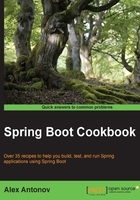
Conventions
In this book, you will find a number of styles of text that distinguish between the different kinds of information. Here are some examples of these styles and an explanation of their meaning.
Code words in text, database table names, folder names, filenames, file extensions, pathnames, dummy URLs, user input, and Twitter handles are shown as follows: "We can include other contexts through the use of the include directive."
A block of code is set as follows:
public class StartupRunner implements CommandLineRunner {
protected final Log logger = LogFactory.getLog(getClass());
@Autowired
private DataSourceds;
@Override
public void run(String... args) throws Exception {
logger.info("DataSource: "+ds.toString());
}
}
Any command-line input or output is written as follows:
spring.datasource.driver-class-name: com.mysql.jdbc.Driver spring.datasource.url: jdbc:mysql://localhost:3306/springbootcookbook spring.datasource.username: root spring.datasource.password:
New terms and important words are shown in bold. Words that you see on the screen, in menus or dialog boxes for example, appear in the text like this: " Clicking on Generate Project will download a premade project skeleton for us to start with.".